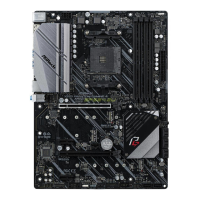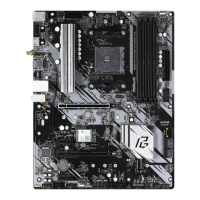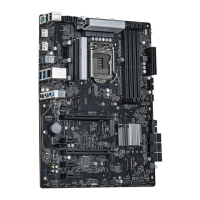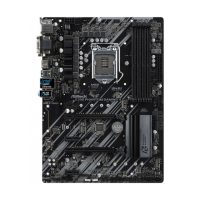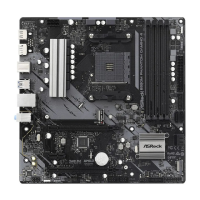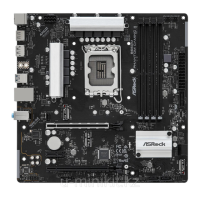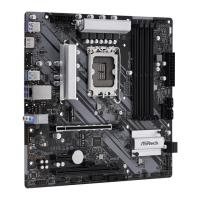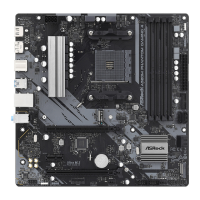Do you have a question about the ASROCK X570 PHANTOM GAMING 4 and is the answer not in the manual?
Lists all items included with the motherboard for initial setup.
Details technical specifications of the motherboard, including CPU, memory, and expansion slots.
Illustrates the physical layout of components and connectors on the motherboard.
Shows rear I/O ports and their descriptions for external connectivity.
Step-by-step guide for safely installing the CPU into the motherboard socket.
Instructions for mounting the CPU cooler and heatsink for effective thermal dissipation.
Guide on correctly installing DDR4 memory modules into DIMM slots for dual-channel operation.
Explains PCI Express slots and their configurations for adding expansion cards.
Describes the function and setup of jumpers, such as the Clear CMOS jumper.
Details internal headers and connectors on the motherboard for system components.
Explains the Post Status Checker feature that diagnoses system functionality during boot.
Guide on setting up multiple graphics cards using AMD CrossFireX technology.
Specific steps for installing two graphics cards to enable CrossFireX functionality.
Instructions for installing necessary drivers and software for graphics card functionality.
Step-by-step guide for installing an M.2 SSD module into the M.2_1 slot.
Instructions for installing an M.2 WiFi/BT module into the M.2_2 slot.
Step-by-step guide for installing an M.2 SSD module into the M.2_3 slot.
Guide on installing essential drivers from the support CD for motherboard functionality.
Explains using Phantom Gaming Tuning software for system performance and fan control.
Information about ASRock APP Shop for downloading software, utilities, and updates.
Guide to customizing RGB lighting effects with Polychrome SYNC utility.
Overview of the UEFI SETUP UTILITY and how to enter it for system configuration.
Describes main menu bar options within the UEFI setup utility interface.
Explains keyboard shortcuts and mouse controls for navigating the UEFI interface.
Details the system overview displayed on the UEFI Main screen upon entry.
Explains the OC Tweaker screen for overclocking system components like CPU and memory.
Covers advanced system configuration options, including CPU, storage, and ACPI settings.
Details CPU-specific settings in the Advanced menu, such as PSS Support and SMT Mode.
Allows configuration of onboard devices like HD Audio, LAN, and USB ports.
Settings for storage devices, including RAID configuration options.
Configuration options for ACPI for power management.
Settings for Super I/O devices, such as serial and PS/2 ports.
Configuration for security device support and Trusted Computing features.
Accesses AMD-specific common options and features.
Accesses AMD-specific platform security features and firmware settings.
Provides options for configuring CPU frequency and voltage for overclocking.
Contains utility tools like RGB LED control, Easy Driver Installer, and Instant Flash.
Allows monitoring of system hardware status, including temperatures, fan speeds, and voltages.
Options for setting passwords and configuring Secure Boot.
Settings for configuring boot device priorities, fast boot, and boot logo.
Options for saving changes, discarding changes, and exiting the UEFI setup utility.
| Processor socket | Socket AM4 |
|---|---|
| Processor manufacturer | AMD |
| Compatible processor series | AMD Ryzen 3 2nd Gen, AMD Ryzen 3 3rd Gen, AMD Ryzen 5 2nd Gen, AMD Ryzen 5 3rd Gen, AMD Ryzen 7 2nd Gen, AMD Ryzen 7 3rd Gen, AMD Ryzen 9 3rd Gen |
| Maximum number of SMP processors | 1 |
| Audio chip | Realtek ALC1200 |
| Certification | FCC, CE, ErP/EuP |
| Component for | PC |
| Motherboard chipset | AMD X570 |
| PC health monitoring | CPU, FAN, Temperature, Voltage, Water cooling |
| Audio output channels | 7.1 channels |
| Motherboard form factor | ATX |
| Windows operating systems supported | Windows 10 x64, Windows 11 x64 |
| ECC | Yes |
| Memory channels | Dual-channel |
| Memory slots type | DIMM |
| Number of memory slots | 4 |
| Supported memory types | DDR4-SDRAM |
| Maximum internal memory | 128 GB |
| Supported memory clock speeds | 2133, 2400, 2667, 2933, 3200, 3466, 3600, 3733, 3800, 3866, 4000, 4133, 4200, 4266, 4300, 4400, 4466 MHz |
| Supported memory clock speed (max) | 4466 MHz |
| Supported memory module capacities | 4GB, 8GB, 16GB, 32GB |
| BIOS type | UEFI AMI |
| ACPI version | 5.1 |
| BIOS memory size | 256 Mbit |
| System Management BIOS (SMBIOS) version | 2.3 |
| DirectX version | 12.0 |
| Maximum resolution | 4096 x 2160 pixels |
| Parallel processing technology support | CrossFireX, Quad-GPU CrossFireX |
| DisplayPort version | 1.2 |
| WiFi-AP antenna jack | 3 |
| USB 2.0 ports quantity | 0 |
| USB 3.2 Gen 1 (3.1 Gen 1) Type-A ports quantity | 6 |
| USB 3.2 Gen 2 (3.1 Gen 2) Type-A ports quantity | 2 |
| Wi-Fi | No |
| LAN controller | Intel® I211-AT |
| Ethernet interface type | Gigabit Ethernet |
| Number of SATA III connectors | 8 |
| Supported storage drive interfaces | M.2, PCI Express 3.0, SATA III |
| Cables included | SATA |
| Harmonized System (HS) code | 84733020 |
| Depth | 229 mm |
|---|---|
| Width | 305 mm |
